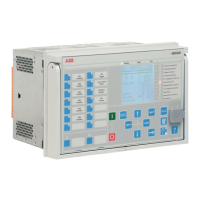U
I
n
R R R
I
n
R
k in
in m s
k in
smax
max max
= × + +
( )
≈ ×
(Equation 112)
I
kmaxin
The maximum fault current inside the zone, in primary amperes
n The turns ration of the CT
R
in
The internal resistance of the CT in ohms
R
m
The resistance of the longest loop of the CT secondary circuit, in ohms
R
s
The resistance of the stabilized resistor, in ohms
The peak voltage û, which includes the CT saturation, is estimated with the formula
(given by P.Mathews, 1955)
(Equation 113)
U
kn
The knee point voltage of the CT
The VDR is recommended when the peak voltage û ≥ 2kV. This the insulation level
for which protection relays are tested.
For example, the maximum fault current in case of a fault inside the zone is 12.6 kA
in primary, CT is of 1250/5 A, that is, ratio n = 240, and knee point voltage is 81 V.
The stabilizing resistor is 330 Ohms.
U
A
V
max
= ⋅ Ω =
12600
240
330 17325
(Equation 114)
˘
.u kV= ⋅ ⋅ −
( )
≈2 2 81 17325 81 3 34
(Equation 115)
As the peak voltage ȗ = 3.2 kV, VDR must be used. In some cases, VDR can be
avoided if R
s
is smaller. The value of R
s
depends on the protection relay operation
current and stabilizing voltage. Thus, a higher setting in the protection relay must
be used or the stabilizing voltage lowered.
Flux-balancing principle
When the function block is used with the flux-balancing principle, there are no extra
requirements for the measuring devices. The core-balance transformers used in an
ordinary overcurrent protection are adequate here as well.
4.3.6.7 Example calculations for high-impedance differential protection
The example shows the calculations for the
Operate value
setting, stabilizing
resistor value (R
s
) and required knee point voltage (U
kn
) of the CTs.
Protection functions
1MRS757644 H
604 620 series
Technical Manual

